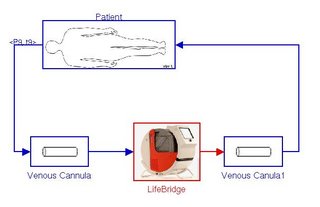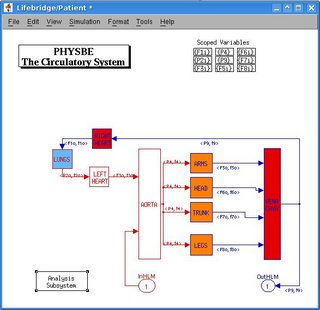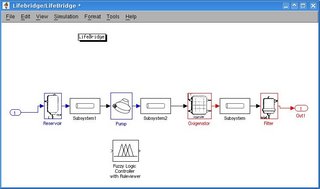Lifebridge Project
Description
In Germany approx. 300 000 people die every year of the results of a coronary heart disease. 10% of these deaths result from a cardiogenic shock. As a result of the cardial pump failure inferior per-fusion comes to the other organs causing a mortality of 50 to 90% . These patients could be treated with the use of an extracorporeal circulation, i.e. by connection of a heart lung machine (HLM) and with that guarantee to be kept alive before a multi-organ failure. With a mobile HLM these patients could be stabilized on the spot and stabilized during transportation to a definitive care in a heart center.
This application relates to the provision of the bases for the development of a mobile HLM which also ensures an optimum perfusion outside a heart centre and in typically hectic emergency situations (for example during a use in the ambulance), and to be more precise at minimal service requests to the highly specialized doctor.
LifeBridge
The Lifebridge HLM is comparable in construction with a conventional Heart Lung Magine. The components with which it is built have been used in the clinical routine business for many years, where maximum amount of safety and reliability can be guaranteed.
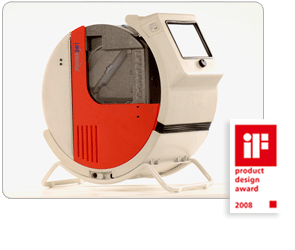
Sensors
Lifebridge will not be in the position to be used by a specialist (Caridio technician) as a mobile HLM. For this reason an automatic control of the system is necessary to be able to guarantee the optimal per-fusion conditions for the patient. The prerequisite for the automation of the HLM is the online measuring of single blood values as well as the dynamic parameters of the blood this can be done with the following sensors:
- Pressure Sensors
- Flow Sensors
- ECG capturing
- SpO2 Sensor (Oxigen Saturation in blood)

Modeling of the circulation at an extracorporeal circulation
The human blood circulation represents a complex system with a variety of influence variables. The interactions shall be examined between the control quantities which can have an effect with the HLM and the circulation behavior of the patient. This includes different types of patients and under different environment conditions.
Fuzzy Controler
This project takes in mind the implementation of a fuzzy controller. The advantage of using this type of controller in the domain of for medical systems is the possibility of using "if then " rules which enables to input the knowledge and experience of the medical doctors doctor directly into a model. This model can then be implemented in an engineer-like development using regulators or expert systems.
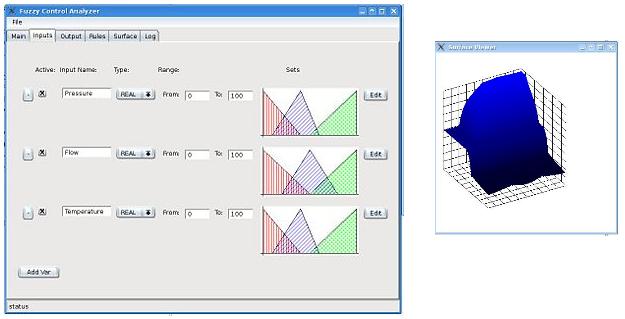
Experimental Setup
With the collaboration of the German Heart Center we are able to perform experiments where it is possible to obtain a better understanding of the behavior of the different parameters involved in the development and the verification of the controller.


People
- Dr. Alejandro Mendoza
- Dipl.-Ing. Benedikt Baumgartner
Partners
German Heart Center
- Prof. Dr. med. Robert Bauernschmitt
- Dr. med. Markus Krane
- Dr.-Ing. Ulrich Schreiber
Lifebridge
Publications
| [1] | A. Mendoza Garcia, M. Krane, B. Baumgartner, N. Sprunk, U. Schreiber, S. Eichhorn, R. Lange, and A. Knoll. Automation of a portable extracorporeal circulatory support system with adaptive fuzzy controllers. Medical Engineering & Physics, 36(8), august 2014. [ .bib ] |
| [2] | B. Baumgartner, A. Mendoza, S. Eichhorn, U. Schreiber, and A. Knoll. A comparative study on extra-corporal circulation control. In International Conference of the IEEE Engineering in Medicine and Biology Society (EMBC), pages 4287-4290, 2011. [ DOI | .bib | .pdf ] |
| [3] | Benedikt Baumgartner, Alejandro Mendoza, Ulrich Schreiber, Stefan Eichhorn, Markus Krane, Robert Bauernschmitt, and Alois Knoll. A 4-layer supervising unit for extra-corporal circulation. In Proceedings of the 4th International Conference on Bioinformatics and Biomedical Engineering, 2010. [ DOI | .bib | .pdf ] |
| [4] | B. Baumgartner, A. Mendoza, U. Schreiber, S. Eichhorn, M. Krane, R. Bauernschmitt, and A. Knoll. A comprehensive approach towards extra-corporal circulation control using fuzzy logic. In Proc. IEEE International Conference on Fuzzy Systems (FUZZ-IEEE), 2010. [ DOI | .bib | .pdf ] |
| [5] | Benedikt Baumgartner, Alejandro Mendoza, Ulrich Schreiber, Stefan Eichhorn, Markus Krane, Robert Bauernschmitt, and Alois Knoll. A simple fuzzy controller for an extra-corporeal circulation system - limitations and potentials. In Proceedings of the 5th Russian-Bavarian Conference on Bio-Medical Engineering, 2009. [ .bib |.pdf ] |
| [6] | Ulrich Schreiber, Stefan Eichhorn, Alejandro Mendoza, Benedikt Baumgartner, Robert Bauernschmitt, Rüdiger Lange, Alois Knoll, and Markus Krane. A new fuzzy controlled extracorporal circulation system. first results of an in-vitro investigation. In Proceedings of the 36th Annual Meeting of Computers in Cardiology, 2009. [ .bib | .pdf ] |
| [7] | M. Krane, D. Mazzitelli, U. Schreiber, A. Mendoza, B. Voss, C.C. Badiu, R. Bauernschmitt, and R. Lange. First experience with a new portable cardiopulmonary bypass system - lifebridge b2t with percutaneous femoral cannulation. In Proceedings of the 35th Annual Meeting of Computers in Cardiology, sept 2008. [ .bib |.pdf ] |
